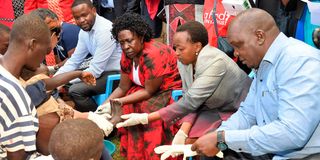More than 1.4m Kenyans have jiggers, Health Ministry says

First Lady Rachel Ruto (second right) with Mrs Precelia Oparanya (third right) and Dr Kamau of Ahadi Kenya during a past anti-Jiggers campaign at Butere Primary School in Kakamega County.
At least 1.4 million Kenyans have jiggers, according to a report released by the Ministry of Health.
The ministry’s head of Public Health, Susan Mutua, said Central, Western, Nyanza, Coast and Rift Valley are the leading regions in jigger infestation.
During events to mark the International Jigger Awareness Day in Khwisero, Kakamega County, yesterday,
Dr Mutua said more than 17,000 school-going children aged six to 15 years in 19 counties are affected.
“At least a million Kenyans are at risk of infection,” Dr Mutua said.
“Years ago, jiggers were associated with village life. It is now a national threat. Jiggers are a socio-economic burden to the victims and the economy of the nation. The most affected people are children, the disabled and the elderly.”
She added that the ministry has launched the National Policy Guideline on Prevention and Control of Jigger Infestation in Kenya.
“The policy brings on board players from government departments and addresses the plight of jigger victims,” she said.
The framework, Dr Mutua said, emphasises a multi-sectoral approach addressing the underlying causes of jiggers, awareness campaigns, social support and poverty reduction.
“The guidelines explain measures on prevention, control and the eventual eradication of jiggers. They are also aimed at strengthening the capacity of jigger control and advocate the use of pesticides to control the pests at the household level,” she said.
“They take medical practitioners through treatment procedures in addition to a nationwide survey of jigger prevalence. It is a must-have document for stakeholders in this battle.”
Dr Mutua said social neglect, poor personal hygiene and environment sanitation and inadequate water supply are the risk factors associated with the infestation.
“Unlike other diseases which do not discriminate between social classes, jiggers mainly hit vulnerable and neglected households,” she said, urging community health workers to collaborate with the ministry and ensure high levels of sanitation in homes.
Jiggers (chigoe flea), are parasitic arthropods found in tropical and subtropical climates.
Introduced to Sub-Sahara from their native Central and South America a few centuries ago, the female 1mm-long flea burrows into an exposed skin on the feet of a mammal, remaining there for two weeks while developing eggs.
The feet swell and cause irritation, a condition called tungiasis.
Ahadi Trust Kenya CEO, Stanley Kamau, challenged national and devolved governments to conduct a national census on jigger infestation.
He said that would enable stakeholders plan towards eradicating the parasite.
Dr Kamau added that the census would help actors in the eradication scheme identify the number of people affected and the most notorious type of jigger in a particular area.
“We are not sure how many people are infected with jiggers in Kakamega County, for example. What we are treating today is a fraction,” he said.
Kakamega County Health Executive, Bernard Wesonga, said the devolved government sets aside Sh5 million for the eradication of jiggers every financial year.





